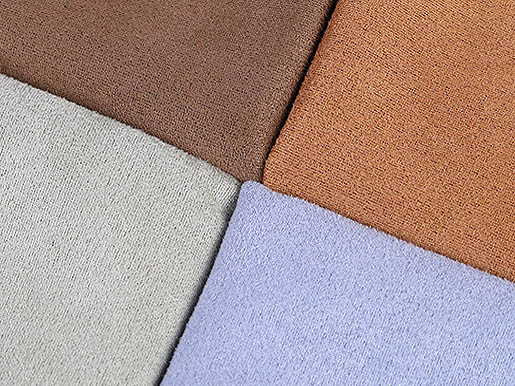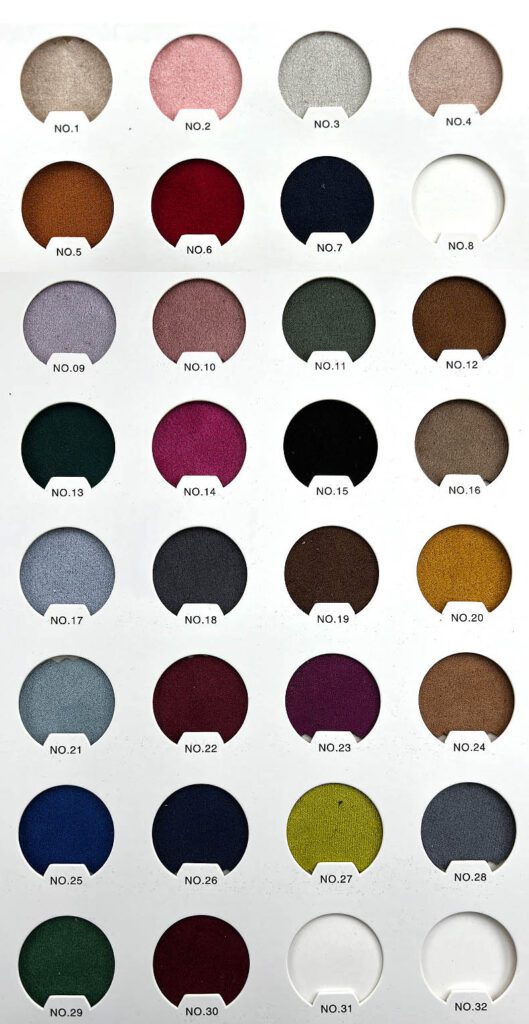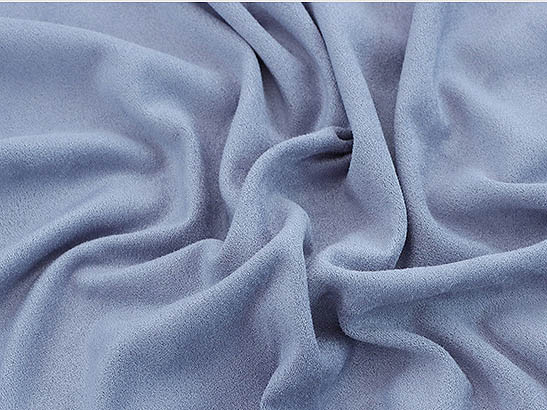Suede Fabric
Suede fabric is a luxurious material celebrated for its velvety softness and sophisticated appearance. Renowned for its durability and versatility, suede is a top choice for designers aiming to create high-quality fashion pieces and accessories. Its breathable nature ensures comfort, making it ideal for various applications, from apparel to home decor.

Key Features
- Opulent Texture
- Superior Durability
- Exceptional Breathability
- Versatile Applications
- Eco-Conscious Options
Specifications
- Material Composition: 100% genuine leather or high-quality synthetic alternatives
- Fabric Weight: 200-250 GSM (grams per square meter), offering a balance of lightweight feel and substantial quality
- Width Range: 54-60 inches, accommodating various design requirements
- Color Availability: Extensive palette including classic neutrals and bold, vibrant hues
- Finishing Techniques: Advanced water and stain-resistant treatments for enhanced durability
Available clothing types
- Suede micro mini culottes tan
- Ottoman tube top for women coconut/black
- Men's Brown Pickup Trucker Jacket
- Brown suede women's trousers

Unique Processing Techniques
Specialized Brushing: Suede undergoes a meticulous brushing process to develop its signature nap, resulting in a soft and velvety finish that is highly coveted. This process involves delicate sanding of the leather's underside, creating a texture distinct from the smooth finish of regular leather.
Advanced Dyeing: Utilizes cutting-edge dyeing techniques to ensure rich, vibrant colors that resist fading and maintain their brilliance over time. This process involves the use of specialized dyes that penetrate deeply into the fabric fibers, ensuring consistent color throughout.
Protective Finishing: Treated with innovative water and stain-resistant coatings, enhancing the fabric’s durability and usability across various applications. This involves applying a protective layer that repels liquids and prevents stains, maintaining the fabric's pristine appearance.
Available colors

Differences from Ordinary Fabrics
- Texture and Aesthetics: Unlike ordinary fabrics, suede has a unique nap that gives it a luxurious, velvety feel. This texture is achieved through the specialized brushing process that is not typically used for standard fabrics.
- Enhanced Durability: Suede is more durable than many ordinary fabrics due to its leather origin and the additional protective treatments it undergoes. While regular fabrics might wear out or fade quickly, suede retains its appearance and integrity for longer periods.
- Maintenance Requirements: Suede requires specific care techniques, such as dry cleaning and regular brushing, to maintain its quality. Ordinary fabrics often have simpler care instructions but do not offer the same level of elegance and durability.
- Eco-Friendly Alternatives: Synthetic suede provides a sustainable alternative that mimics the luxurious feel of genuine suede, an option not always available with standard fabrics.
Application scope
Fashion Apparel: Perfect for crafting elegant jackets, skirts, pants, dresses, and blouses that exude sophistication and style.
Footwear: Ideal for stylish and durable shoes, boots, and slippers, combining aesthetics with functionality.
Accessories: Excellent for creating premium handbags, belts, hats, and gloves, adding a touch of luxury to everyday items.
Home Decor: Suitable for upscale cushions, upholstery, and decorative pieces, elevating interior design with its luxurious texture.
FAQs
What sets suede apart from other fabrics?
- Suede’s unique texture, created through a specialized brushing process, provides a soft, luxurious feel that is unmatched by other fabrics.
Is suede suitable for outdoor wear?
- While suede can be treated for water resistance, it is generally best suited for indoor or mild outdoor use to maintain its quality and appearance.
How does synthetic suede compare to genuine suede?
- Synthetic suede offers a similar look and feel to genuine suede, with added benefits such as easier maintenance and often lower cost, making it an excellent choice for various applications.
What are the best practices for maintaining suede garments?
- Regularly brush with a suede brush to keep the nap fresh and free of dirt. For deeper stains, seek professional cleaning services to avoid damage.
How to view the complete FAQ
The Elegance of Suede Fabric
Suede fabric is a type of leather made from animal hides, characterized by its napped surface. It is primarily used for making jackets and shoes.
During the Romantic era, Swedish leather exports were highly favored by French nobility. This animal leather fabric was known in French as "gants de suede," meaning "gloves from Sweden."
Suede fabric is renowned for its unique, soft, and delicate touch. Because of these qualities, suede has long been associated with high-end luxury.
What is Suede Fabric?
Suede is a leather made from the underside of animal hides, typically from goats or lambs. It is woven from finely spun yarns, making it soft and thin.
The fabric's napped and fuzzy surface gives it a distinctive texture.
Suede is commonly used to make jackets, shoes, and wallets. It is also considered a luxurious leather due to its unique qualities and elegant appearance.
Types of Suede Fabric

In the past, suede fabric was made exclusively from animal hides. Today, thanks to modern technology, suede can be produced through various methods.
Genuine Suede Only leather obtained from animals is considered true suede. Genuine suede can be made from different types of animals:
Sheepskin: This type of genuine suede has a fine, napped texture. It is lighter and thinner than other types of genuine suede and has a silky touch. Sheepskin, also known as lambskin, is perfect for clothing.
Pigskin: Authentic suede made from pigskin is more durable and thicker, ideal for making wallets and gloves.
Cowhide: For those seeking durability, cowhide is the best option. It is the roughest and most durable of all suedes. Calfskin can be used for a less coarse texture.
Deerskin: Similar in texture to sheepskin, deerskin is more expensive and keeps cool in the summer and warm in the winter.
Synthetic Suede
Synthetic suede is not derived from animal hides but is designed to mimic genuine suede. It is cheaper and easier to care for than real suede. This man-made fabric is considered an affordable luxury and is commonly more durable.
Ultrasuede: Developed in 1970 by Miyoshi Okamoto, Ultrasuede is a branded synthetic suede made of 20% polyurethane (PU) and 80% polyester microfiber. It looks similar to genuine suede but is easier to maintain.
Microsuede: This fabric emerged after the patent for Ultrasuede expired. Microsuede is similar but has more features, including stain resistance, waterproofing, and durability.
Other Types of Suede Fabrics
Suede Silk: Through chemical processing, silk can mimic the texture of suede, resulting in suede silk—a type of faux suede.
Suede Cotton: Similar to suede silk, cotton fibers can be treated chemically to give the fabric a rough surface resembling animal suede.






